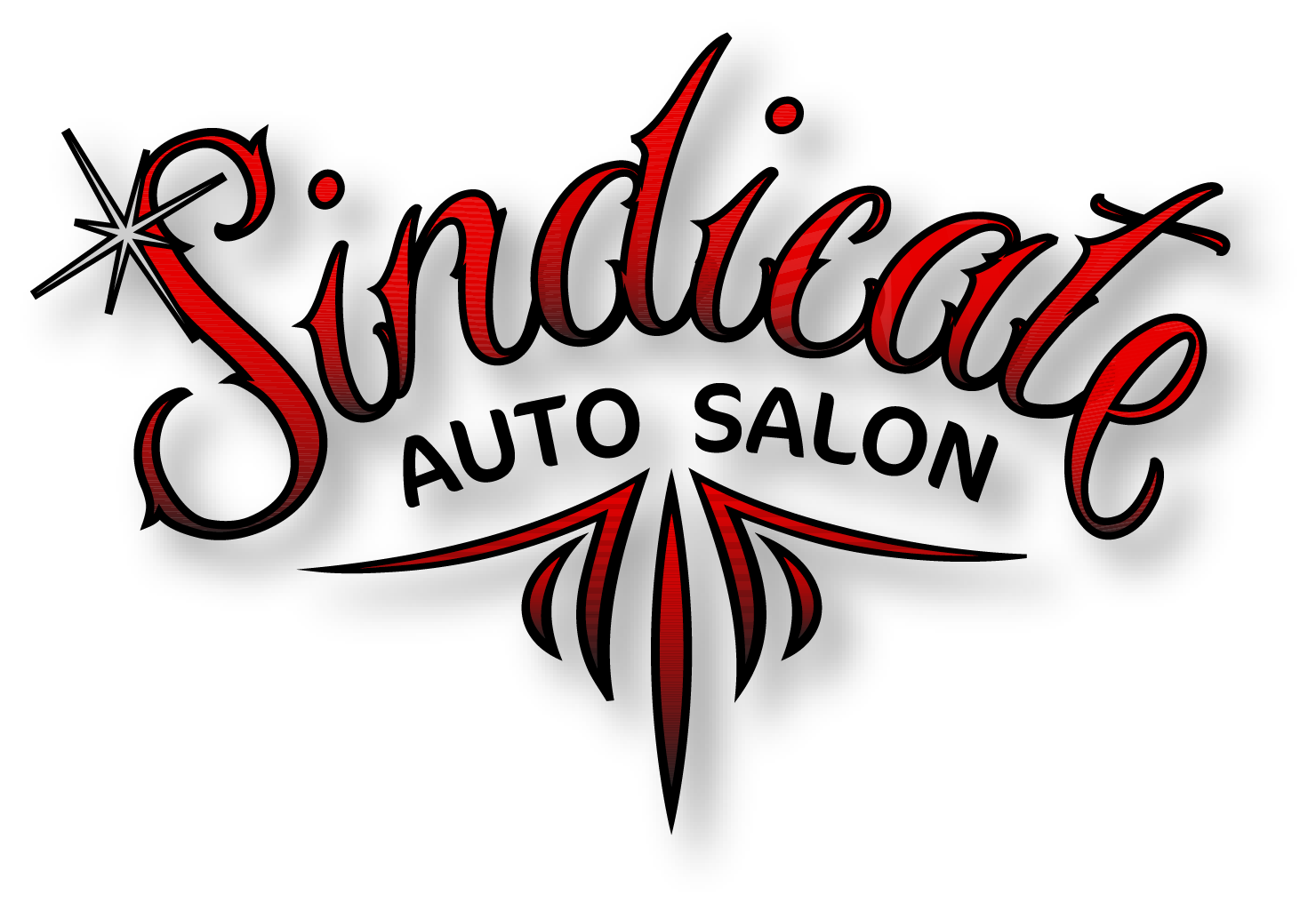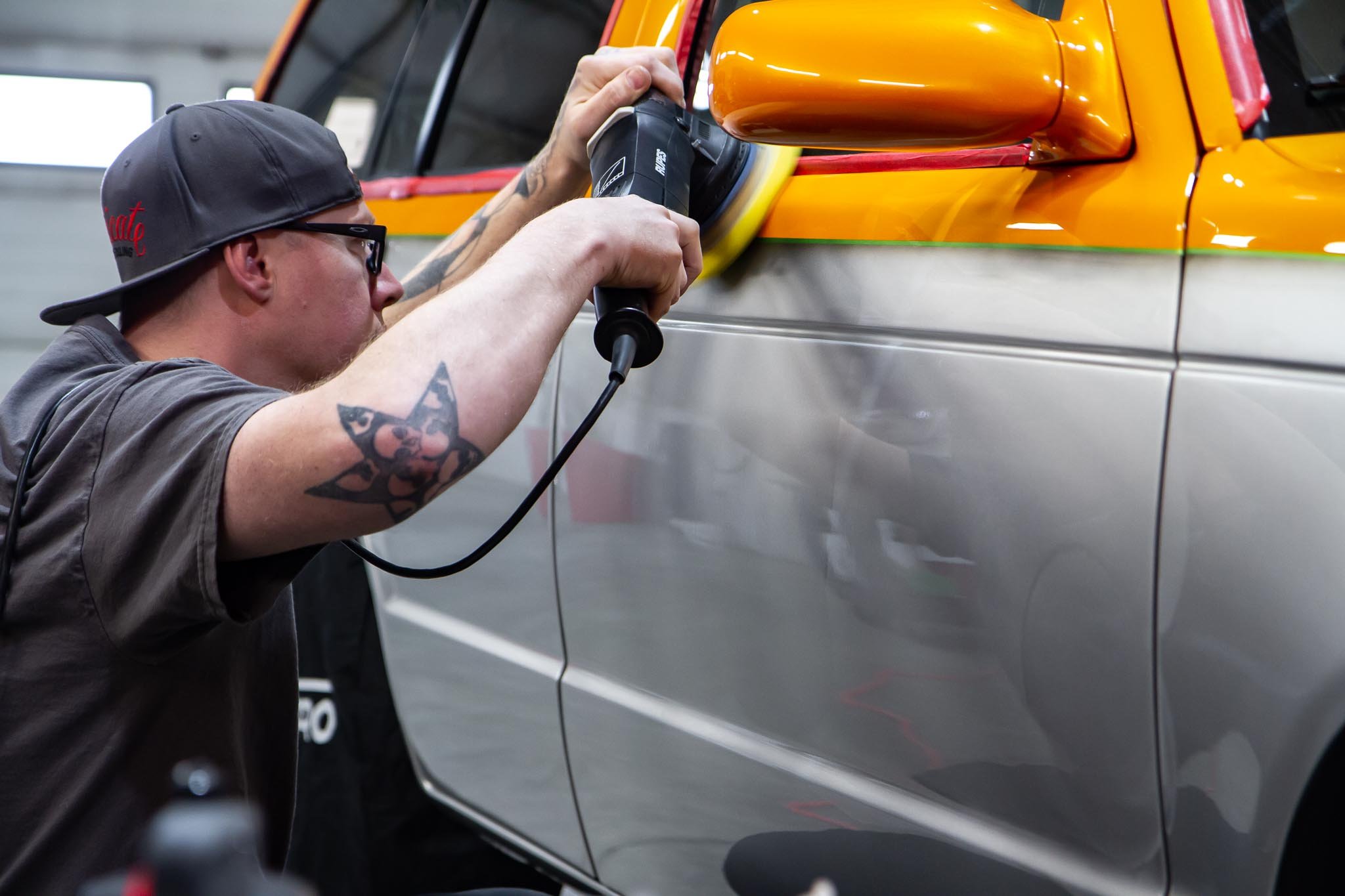What Do Detailers Do to Make Your Paint So Smooth And Shiny? Understanding Your Cars Paint And The Art Of Correcting It.
Does your car have scratches, swirls or appear to have faded? Paint correction is the perfect option for you. What does that mean?
More fine tuned than polishing, paint correction requires multiple steps to remove surface imperfections like scratches, swirls or oxidation.
Power polishing, buffing, cut and polish, these are all terms you might have heard when it comes to polishing your vehicle, and they are what’s referred to as Paint Correction.
Sindicate Auto Salon specializes in this process, so we’re here to break it all down for you.
What is Paint Correction?
Put simply, paint correction is the process of removing microscopic layers of your clear coat to remove defects. When done correctly, this transforms the painted surface to a smooth, uniform finish.
This process is technical and should be left to trained individuals, otherwise you risk permanent damage to your paint.
Before we dive into the costs and process, we’ll discuss different paint defects since the level of correction needed is unique to the type of defect.
The image below shows common defects and how they affect your clear coat.
Paint correction can be an extensive process, and it has limitations regarding the severity of the damage. For example, deeper scratches require a skilled wet sanding procedure to improve the defect. Scratches which have penetrated past the clear coat cannot be completely eliminated with paint correction, since the damage is farther than any polishing can provide.
That being said, scratches that deep can be made less apparent with paint correction.
The Process
Before we begin, we require a properly prepped and clean surface. This means a decontamination wash, which includes both a clay bar treatment and a chemical decontamination. This process removes traces of tar, iron particles (also known as industrial fallout), rail dust, tree sap, bird droppings and any previous protection, like waxes or sealants.
Once prepped, we complete a paint analysis. This is where we assess the vehicle’s entire painted surface to measure and record thickness on each panels. To make sure we don’t burn through clear coat, we must ensure there is enough paint on the panel to proceed safely.
Next, we determine our plan of attack which is based on your personal expectations and the extent of the imperfections.
Our first step is to select correct cutting pads and compounds to vigorously remove deep scratches in the clear coat. Depending on the level of correction, this step could be repeated multiple times, or possibly wet sanding on certain scratches to dig a bit deeper.
After the cutting stage there will be micro-marring or a haze left behind, this is where we fine tune the surface with polishing. This is the part everyone loves since we start to reveal all the hard work we put in while cutting.
For polishing we switch to a softer, less aggressive pad and polish, and go over the entire surface to remove any haze or micro scratching. This will elevate your paint to a smooth and glossy finish.
Some paint is more delicate and demanding than others, like black paint, which may require a second polishing stage with an even softer pad and a jeweling polish.
With the new gloss and shine revealed, we have to take a step back and admire all of the hard work to get to this point, but… we aren’t done yet. Now that we have perfected your paint, we will need to protect it.
There are a few options for this. You might be familiar with carnauba wax, which is great for adding depth to your paint to make it look “wet”. However, with modern technology, we have the option to add polymer paint sealants and the ever so popular ceramic (nano) coatings.
Protecting the Perfection
The carnauba wax we mentioned above has almost become obsolete due to major technological advances in the car care industry. These advancements included stronger, longer lasting products for both the professional detailer and the consumer.
Everyone can appreciate the joy of waxing your car - seeing the depth, gloss and hydrophobic properties that it offers can be satisfying, but unfortunately it just doesn’t last.
Being made of natural products, it’s destined to get broken down by the sun and the harsh chemicals we use at the car wash. Typically, a month would be considered a long time for a wax application to last.
With this, the industry was presented with Polymer paint sealants, a great improvement over traditional waxes as they offer longer protection and a much easier application process in a spray on and wipe off formula.
Polymer paint sealants will offer a lifespan of 6-8 months, making this is a great product for the DIY consumer. This solution is our go to product for the client that isn’t in need of long term protection with ceramic coatings.
Speaking of Ceramic coatings… let’s take a look at this popular protective option.
Over the last 10 years these products have taken off, and you’ve probably heard the term Ceramic being used lots, becoming a buzzword in the recent years.
With “ceramic” becoming a popular term, it’s important you’re careful and not swayed by lesser quality products that try and cash-in on trending terms.
It’s common to find low quality detail products boasting the word ceramic, but unfortunately they fail to offer the same protection that a professional grade ceramic coating would.
With professional ceramic coatings being a semi-permanent form of vehicle protection, everyone seems to want (and need) it. If you ask us, not just as detailers but as car enthusiasts, we absolutely agree.
There are multiple coatings out in the world offering anything from 1 Year to lifetime protection. In our professional opinion, a “lifetime” coating can’t be a legitimate product. Quite honestly, this is likely a gimmick. Why? Well, if your clear coat cannot last a lifetime, then how could you except a coating to? Why wouldn’t companies use that method instead? Because it isn’t truthful. If it sounds too good to be true, it probably is.
At Sindicate Auto Salon, we have done extensive research and chosen trusted, quality products to meet our clients needs. We offer 1, 3, 5, & 7 years coatings, as we feel these best suit our clients individual needs for longevity.
Paint Thickness
As we mentioned above, we always measure the thickness of the paint and clear coat prior to beginning any correction. This process is very important and also gives us a lot of information about your vehicle.
Based off the readings, we determine if there is enough clear coat (or paint for vehicles painted with single stage paint) to safely perform a paint correction without causing premature clear coat failure.
What is clear coat? This is the clear layer that was sprayed over top of the base colour, protecting the vehicle’s paint against damaging UV rays and everything else the world throws at it.
Traditionally, your paint job will be composed of three separate layers:
• Primer (To create a surface that is prepped for paint)
• Base coat (Which is the colour of your paint)
• Clear coat
Majority of your vehicle’s paint thickness is the clear coat. This is what gives us the ability to lessen imperfections, but there comes a point where it isn’t safe to further paint correct, and we have to tread lightly in those areas.
As newer vehicles are being produced, we are seeing a trend that manufacturers are using less and less clear coat, year after year. This is a problem in the paint correction world, giving us less to work with. Not only that, but it makes it crucial for consumers to add protection right from the showroom floor.
Recommended protection includes either clear PPF (Paint Protection Film or Clear Bra) or a ceramic coating to ensure the paint lasts.
Whatever the current stage is on your vehicle’s paint, we will never jeopardize the clear coat. If it came to this, we would much rather tell you no than do anything that could damage your vehicle.
The Tools
There are a variety of specialty tools required for this job. We use multiple machine polishers to ensure we give our client the most precise final product possible. Then, we have polishing pads that vary in size, media and density. Each of these serve a purpose, and we use multiple of each to ensure we are providing you with consistent results.
The chemicals are also a factor in the paint correction process. From cutting compounds to jeweling polishes, we make sure we have the right product for the specific job.
Microfiber towels are often overlooked in the paint correction process, but they play just as important of a role. Here, we use high quality towels on your vehicles paint, lessening chance of the towel inducing additional scratches.
Even with specialty tools, we couldn’t provide you with a great paint correction if we cant see what we are working on. That is why we use LED lights, designed specifically for body shops who also require ample amounts of lighting. These professional lights expose imperfections and allow us to see every defect in your vehicles paint.
We have gone great lengths acquiring these tools to provide you with the best possible outcome. But we will let our work speak for itself.
The Cost of Paint Correction
Paint correction prices as a whole can vary, as the extent of your correction will depend on:
• The current condition of the paint
• Your personal preference and expectation
We can spend anywhere from 8 hours up to 30+ hours to perfect vehicles paint. For example, you know custom show cars that have paint that looks as if its as smooth as glass? That takes weeks of correction to achieve.
To prevent surprises, we recommend starting with a consultation so our professionals can look over the condition of your vehicle’s paint to better understand what we’re working with. We’ll also ask your expectations for the end result, and with those factors considered we will be able to give you an estimate for this specialty service.
Conclusion
If you think you vehicles paint is looking faded or dull, or your have scratches or swirls that you want taken care of, get in touch with us and we can asses your vehicle and provide you with a solution to meet your specific needs.
Our knowledgeable and trained professionals will get your vehicle looking its best.












